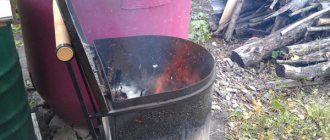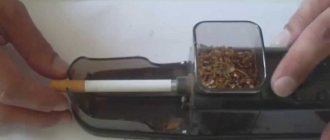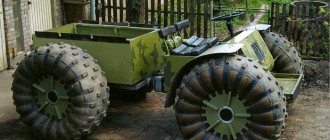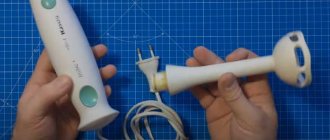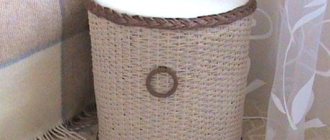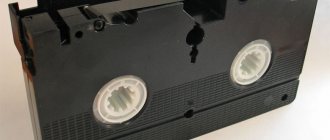YouTube has presented a lot of videos, notably where a couple of men catch Eurosat using a bucket lid. Satellite transmissions to a device for pointing a dish... The video was most likely preceded by considerable experience of the master and preliminary adjustment. We'll tell you what the matter is below. Today we will discuss how a satellite dish can be made with your own hands from scrap items. You need to understand: in any case you will have to buy an irradiator (converter). The device contains a lot of electronic components inside; the exact composition and purpose are a trade secret of the manufacturing companies. One thing is important to the designer: the converter is configured for the broadcast range. As for polarization, you can change it, we have already said it and we will repeat it.
Satellite dish design
The operating principle of satellite antennas is limited to the conversion of air waves into electrical vibrations of the receiving probes of the converter. The signal is amplified, removed from the carrier, and transmitted to the receiver or television set. The satellite is far away. Flies in an orbit located exactly above the equator at a speed that allows it to remain motionless in the sky. It makes a full revolution around the Earth every day. One satellite covers a large area. Thousands, millions of square kilometers. It is clear that the area leaves no choice: the signal level is negligibly low, otherwise the power consumed in orbit would increase, and broadcasting would become impossible.
Typical antennas are unable to receive such a low signal level. Plates are used. The scientific name of the structures is parabolic antennas. The shape of the dish follows a paraboloid, the key feature of which is the optical law: rays of one direction are collected by the focal plane. Everyone knows a lens that is built on this basis is capable of collecting solar rays. The dish similarly concentrates the satellite signal to one point, where the strength is much greater than the average broadcast.
The gain of parabolic antennas is rarely below 20 dB. You will find specimens that provide 40 dB or more. At the same time, interference is cut off, because reception is carried out from a narrow direction.
Let's discuss the actions of the master in a YouTube video. I didn't use an ordinary bucket lid! – I found a curved one, similar in shape to a paraboloid. What's left to do next? Find the focal plane, position the converter as needed so that it fits into the place where the rays are collected by the point. It is unknown how much time was spent on preliminary adjustment, we will describe the experiment so that readers understand:
Experience explains two things:
- You can only construct a plate with your own hands. Not a converter. The point is to find a position where the signal will be stable, the problem is: at the slightest deviation of the antenna shape from the paraboloid, the gain drops sharply.
- Setting up a homemade satellite dish is done in a natural manner. It is necessary to find the correct azimuth and elevation angles. In the case of Tricolor TV, you don’t have to turn the converter, the polarization is circular. Reception of foreign channels is carried out - make sure that a converter with linear polarization is selected. We find out the angle of inclination using the online calculator of the provider, the owner of the spacecraft.
There is a known case where satellite dishes came from a military assembly line onto the shelves... of a children's store. There was a defect, the deviations were negligible, the bigwigs of the then progress could not come up with anything else but to hand over the best plates to ordinary people in the form of children's sleighs. It is clear that the fact of sale became known to local radio amateurs, and the products were crushed. We believe that today those plates will give a hundred points head start to any Chinese paraboloids. Instead of a bucket, it is more advisable to attach such a “sled”; reception is guaranteed in bad weather and calm.
When designing a homemade satellite dish, immediately find out what type of converter you will need. Two features are important:
- type of polarization;
- bands C, Ku.
Parameters are used in different combinations. One satellite has several bands, polarization varies. Multifeed is used. A guide on which several converters are installed, each to its own companion. It is difficult to aim two or three at one spacecraft. The signal quality will certainly decrease. It is important to know: there are hybrid converters in the store; none will provide reliable reception in all cases. Surely one range suffers. Avoid being surprised by this fact; it’s better to read the forums, where the problem is fully explained in simple terms.
Design your own satellite dish
We said earlier that at the slightest deviation of the paraboloid shape factor from the specified one, the technique drops. How to make a satellite dish as close to the correct shape as possible. Let's answer the question. Have you ever seen how ships are built? Assembled in sections. More often, parallelepipeds of various sizes are installed in place by crane and welded. The individual sections of the bottom are elaborately shaped, creating an interesting device useful in constructing a parabolic antenna.
First, we recommend studying the market. Avoid being out of line with factory satellite dishes. The country does not like unusual things of local origin, but carrying foreign clowns on their arms is a tradition. A homemade satellite dish should not differ from purchased ones when viewed from afar. Helps you avoid problems. It is impossible to install a purchased kit without permission without a design, let alone a homemade satellite dish.
So, adaptation. Imagine a frame of cross-welded guides on which profiles are welded vertically to form the desired part of the bottom. We know the formula of a paraboloid (it’s easy to adjust the dimensions by doing research in a store), therefore, let’s draw a cross-section on a sheet of paper. Guided by a paper template, we cut a number of profiles out of plywood, place them along a corner and a ruler, forming part of a paraboloid.
It’s not difficult to carefully make a paraboloid from fabric and glue. When the structure is completely dry, it is necessary to cover the inner surface with smooth aluminum foil. You will get a mirror in which you will see yourself. It is worth remembering that matte foil is suitable; the smallest roughnesses that scatter light have less effect on the reflection of radio waves. Try to smooth it out.
The converter stand should be bent in the image and likeness of the store one. Since we know the formula of the resulting surface, we can easily indicate the location of the focus, where we will place the irradiator, facilitating reliable reception. Decide for yourself what to make a satellite dish from; we are sure there will be many model aircraft enthusiasts who use straw. The plate must be rigid and durable, resisting wind, frost, and snowfall. A satellite dish made with your own hands from scrap material will probably be cheaper than a store-bought one, and the plywood guides can be used again. Build crosswise in cells, success will come. The main thing is to maintain the shape factor; the surface should be smooth.
It’s easier to slowly assemble a plywood frame and glue the structure together than to carry a satellite television set. By the way, it is not necessary to take the bucket lid. Any metal surface that resembles the base of a paraboloid. Bend according to the above technology (difficult way). Metal conducts electric current better and collects waves better, forwarding them to the converter.
At the end of the twentieth century, satellite television quickly burst into our homes and began to improve just as quickly. Not everyone probably remembers the first Soviet-made satellite receivers from the Krosna company! It was a huge unit on which only 8 channels could be configured by rotating the variable resistor wheels. But progress in this area has led to the fact that the equipment for receiving satellite television began to rapidly age. The analog signal was replaced by a digital signal of the MPEG-2 standard, and now it is already living its last days, after the introduction of the MPEG-4 standard, which MPEG-2 receivers can no longer receive and decode...
Naturally, analogue and digital satellite receivers of early models began to rapidly accumulate in the hands of the population and also in landfills. For ordinary people, this is just garbage, but for us, radio amateurs, it is a rather valuable source of parts, cases in which you can assemble some kind of device, connectors, power cords, transformers and ready-made power supplies.
And strange as it may seem, analogue receivers may be of greater interest to radio amateurs because they were assembled using full-size components and, having a considerable current consumption, had power supplies and transformers of decent power. You can also profit from displays, high-frequency units and ordinary capacitors, resistors, transistors, diodes, etc.
It all depends on what condition the unit is in and what its configuration is, sometimes it can be used as a clock, a timer with an actuator, but some devices can be used in a more interesting way.
We will talk about tuners with a built-in positioner. A positioner is an electronic device designed to rotate a satellite dish along the orbital axis to various satellites, memorize their positions and then rotate the dish to these positions by supplying a supply voltage of +/- 48 volts to the actuator. The actuator is a DC electric motor with a gearbox and a retractable rod. They come with a retractable part of various lengths: 8-12-18-24-32 inches and can be quite powerful, for example, I know of cases when, on a jammed rotary mechanism, the motor bent the channel ten! There were also tuners with a dual positioner designed to orient the antenna along both the horizontal and vertical axis.
What is the main idea of this review: what can be learned from these devices and how they can be used if they remain functional. If the tuner with a positioner has retained its functionality as a positioner (analog), it can be used for its intended purpose as a positioner, as well as for opening doors, gates, orienting a solar panel, etc. If all the electronics are burned out and cannot be restored, but the transformer remains intact, a transformer-motor pair can be used for the same processes, but with your electronic filling.
The article contained photographs of 2 old receivers and you yourself will evaluate their contents. One of them is an analog Mirage 2200 with a double positioner. I inserted a 3-position toggle switch into it so that I could supply power from it to the motor, without the participation of a positioner.
A satellite dish is a common but expensive pleasure. Many of us have often thought about the question: is it possible to make such a multifunctional antenna on our own? Of course, this is entirely possible! Most often, the question of making a satellite dish with your own hands is asked by people in order to save money or by those who like to conduct experiments. Building a homemade TV dish is not as easy as it seems. When installing it, you need to take into account not only the features of a particular model, but also even the smallest nuances: setting up available satellites, reflection angle, and others. Today we will tell you how to make a satellite dish with your own hands from readily available means. Let's look at the most common ways to make such a device.
TV antennas - satellite and terrestrial
Surely many have long known how satellite TV works and what is needed to start watching news in high quality. But there are probably those who have not thought about this before, and this part of the article will be useful for them, where everything will be sorted out in simple and understandable language. In addition, let's talk about digital DVB-T2 television, which can be watched using a regular antenna.
So, if you want to watch hundreds of channels with news, movies and other programs, you will need a satellite dish.
In this photo there is a Lans plate, apparently 80 centimeters in diameter. The range of antennas starts from a diameter of 55cm, if I’m not confused, and the larger the dish, the more reliable the reception of the satellite signal. It is advisable to use 80-90 cm dishes, then even in bad weather (snowfall or heavy rain) the picture on the TV will not “scatter”, that is, there will be no interference.
“Hole” antenna - there are small holes throughout the entire area of the dish. This is necessary in order to reduce wind load. Such an antenna with perforation will not be swayed by the wind and certainly will not be torn off during a squall. It's a little more expensive, but it's justified.
The antenna must be installed so that it is aimed at the satellite. Literally every millimeter is important. For example, the NTV+ satellite is located in the south, so the antenna is hung on the facade that faces that direction. It is not necessary to hang the antenna on the house; it can hang on a fence or on a tree; in some cases, this is generally the only opportunity to “catch” the signal - visibility must be direct, tall trees often interfere. When we install an antenna, we make sure to tune it and check the signal with a special device!
The so-called converter is mounted on a metal stand. It is needed to convert the satellite signal; it is to this little thing with an orange cap that the antenna cable is connected, which will go to the TV. Converters are different, some can connect only one cable (one TV), some can connect two, some can connect four. There may be models with more outputs, but I doubt that anyone needs more than 4 TVs.
What do you need besides a dish antenna?
The satellite dish does not connect directly to any TV. There are 2 options:
- Connecting the cable to a special receiver. This is a separate box with its own control panel that connects to any TV, like a DVD player or VCR. It is used to convert the satellite signal from the antenna into a television signal. Decodes it. A special smart card is inserted into this box, which you buy from an operator (for example, Tricolor or NTV+), this is needed to pay for access to selected TV channel packages.
- There are TVs on sale with a special CL+ slot into which you can buy and insert a CAM module. This TV has an input for a DVB-S2 antenna cable. That is, the cable from the antenna is connected directly to the TV, a module is inserted into the TV, and a smart card is inserted into the module. This option is convenient - there are no extra wires or extra “boxes”, and most importantly, everything is controlled by one remote control. If in the previous version you had to turn on the TV and adjust the sound with one remote control, and switch channels with another, then here all the controls are on one remote control and that’s great.
At the construction stage, it is advisable to limit yourself to purchasing only an antenna with a converter, fix it on the facade or on the roof, adjust the position to receive a reliable signal from the satellite and run the required number of cables into the house. Each TV is connected with a separate antenna cable and each TV needs its own receiver/module and its own smart card. By the way, each TV is also paid for separately... Therefore, most often the cable from the dish is routed into the living room, where a large TV will appear in the future.
Thus, after finishing the finishing, all that remains is to connect the cable to the TV with the module or receiver; you no longer need to climb onto the roof and touch the antenna.
Digital TV without satellite dish: DVB-T2
Some time ago, digital television broadcasting in DVB-T2 format began. Modern TVs already have a built-in receiver for this type of signal. This differs from the good old antenna in that there is no “snow” or interference. If the reception is confident, the picture will be very clear.
Reception is carried out using a similar antenna. At the time of writing, 20 channels are broadcast in digital format. These are 2 so-called multiplexes, 10 channels each. Multiplex is something like a package of channels that is broadcast at a certain frequency. These are terrestrial channels and they are broadcast for free.
If your TV does not have a built-in digital receiver, separate receivers (“boxes” like those needed for satellite TV) are sold, you can connect such a box to any, even an old TV, and watch TV channels in good quality.
You can read more about digital TV here: https://www.rtrs.ru/dtv/, and you can see the coverage area using this link.
Which is better, satellite or digital TV?
Satellite is better, digital is free, and in general all modern television is junk, but let’s still look at the pros and cons.
So, on the satellite side there is 100% coverage - you can receive a satellite signal anywhere, as long as you have a dish. It can only be difficult in the forest among centuries-old tall trees, but even there you can try to find a “window” and adjust the antenna. The range of TV channels is also on the side of satellite TV - there are hundreds of these channels. Movies, sports, news, educational programs, cartoons - choose what you want, just don’t forget to pay on time. Actually, the need to pay is the main disadvantage, and payment for each connected TV.
And on the side of digital DVB-T2 television there is a lower cost of the antenna, a lower cost of the receiver (or if the TV is a new model, then the receiver is already built in), the absence of a subscription fee and the ability to connect any number of TVs to one antenna. However, you don’t have to pay a subscription fee for over-the-air channels even on a satellite, but on a satellite you have a choice, but here you don’t. The disadvantages include not 100% coverage, somewhere there may be no reception or it will be too weak (see link above) and only 20 channels. Maybe someday there will be more of them.
Many people install both antennas at once. A satellite antenna is connected to a large TV in the living room, where you can watch a movie, and a regular or digital antenna is connected to a TV in the kitchen or bedroom, so you can watch news on federal channels, for example.
Method of gluing with a concrete base
When making a homemade satellite dish, do not forget to draw a detailed drawing of the device, taking into account all measurements and calculations of consumables, in order to get the desired result. It is thanks to your accurate calculations and values that you will save yourself from the risk of getting the wrong shape and similar unforeseen troubles.
The entire manufacturing process of such equipment is as follows:
- We draw a parabola in the drawing, which a little later will be transferred to a steel sheet 0.05 cm thick.
- Using a welding machine, we make a frame from metal rods with a diameter of 10 mm. We bend the steel ribs along the knife, and then weld the bearing onto the top of the structure.
- We install the frame on a flat surface. We mount the pipe vertically in the center under the mounted bearing. After securing the part, install the knife on the bearing of the large washer.
- Fill the plate with thick concrete mortar.
- Dry the resulting matrix for 4-5 days (preferably in the open air).
- Now let's glue the antenna. We divide the finished structure into several parts. We got 8 sectors.
Important! This is necessary in order to make the further work process a little easier. Don't forget to ensure equal spacing between matrix elements.
- For the pattern we use special fiberglass fabric, cut into identical strips, and epoxy primer. Apply regular machine oil to the surface of the now dry matrix, and then place the washer in the installed pipe. We lubricate the matrix with resin, onto which we apply a strip of fiberglass. Smooth the applied component with your hands so that bubbles do not appear on the surface of the glued matrix.
- Cover the reflector with aluminum foil.
That's all the work. This satellite dish can be used for its intended purpose.
Simple techniques step by step
The satellite seems to be a complex structure only at first glance. You can make such a craft with your own hands from anything. You can use regular old newspapers or office paper as a base. The decor will be foil, which every housewife has in her kitchen. The antennas will replace wooden skewers or sushi sticks, or, alternatively, regular knitting needles. In addition to the above, we will need scissors, sewing thread, and tape.
Let's get to work. We form a ball of the required volume from newspapers or paper. It is worth considering the relationship between the size of the ball and future antennas. Antennas should not be too long or short in relation to the base. It is important to convey this information to children - this will be an experience in forming a sense of proportions for them. The workpiece must be fixed. For this we use sewing threads. Then we wrap the future satellite with foil with our own hands.
The next step is designing the antennas. We decorate the wooden sticks with foil and secure the decor with tape, trying not to make “folds.” We don’t wrap the ends of the sticks - they will stick into the base and the decor will be ruined. Knitting needles do not need to be decorated with foil if they are perfectly smooth and shiny.
On a ball of newspaper (paper), thread and foil, make shallow holes with a sharp object (nail, thin blade of scissors, knitting needle). Lubricate the tips of the antennas with glue. It can be either PVA or Moment. We insert the antennas into the satellite and let them dry.
If the craft is being prepared for school, and a child over 10 years old will do it with their own hands, you can complicate the task. You need to prepare:
- threads – sewing, knitting, embroidery;
- a piece of soft cloth or a foam ball;
- cling film;
- needles, pins, scissors;
- glue “Titan” or “Moment”;
- spray paint;
- wooden skewers.
Roll the woven material into a tight ball and cover it with cling film. The foam ball also needs to be tightly wrapped in film so that it holds its shape better. We wrap the prepared base with knitting threads so that they form a continuous layer. We make another layer on top, but this time from sewing threads.
To make a space satellite brighter, you need decor. An excellent option is a star on the surface of the craft, embroidered with your own hands. We will mark the contours of the star with pins and threads of a contrasting color.
We embroider, stick antenna skewers into the ball, smeared with glue and painted with steel-colored spray paint. The work is done.
Do-it-yourself satellite dish at home from foil
It happens that the location of the house does not allow the use of a parabolic dish, so you can build such an antenna with your own hands. It is extremely important to take into account the following basic requirements for this homemade device:
- The need for a TV tower to be 30-50 km away from your home.
- The signal must have sufficient reception from at least several satellites.
- It is advisable that there is a tall structure next to your home - this will make it easier to cope with the task.
Materials and tools:
- Old umbrella.
- A roll of regular foil.
- Antenna cable (preferably copper).
- Can.
- Amplifier with built-in power supply.
Manufacturing:
- We manufacture a satellite array. We measure the interval between all the spokes of the umbrella, the central angle of their attachment and the height of the segment we need.
- We cut out all the parts from the foil, apply them to the triangular parts of the umbrella and sew them with nylon threads to the existing fabric. Using similar manipulations, we cover the entire inside of the umbrella with foil.
- Let's start assembling the signal receiver. We install it at the focus of the satellite array. To do this, you can use a purchased amplifier, or you can make it yourself. To do this, remove 4 cm of braid from the cable, trim the noise-protective layer and leave one central copper core, which will transmit the television signal.
- We cut out an oval part from a beer can, in the center of which we make a small hole. We insert a ready-made cable core into it and solder this contact. We cover the connections with ordinary plasticine to avoid oxidation and corrosion during the operation of the device.
- We attach the resulting receiving apparatus to the handle of the umbrella with ordinary tape, and wind a 10-15 cm cable so that in the future you can adjust the focus of the mirror.
Important! Be careful not to let the receiver come into contact with the metal handle of the umbrella, as this may cause a lot of noise interference. To protect the device from such troubles, we placed plasticine in the area of possible contact, which will serve as a kind of insulator.
- We place a homemade power supply close to the TV, since our amplification device will be powered through an antenna cable.
- We secure the plate with a nylon thread or the upper central tip of the umbrella. We direct it to a nearby source (tower), and then select the focus with the receiver, which was received as a signal on our TV.
Internet outside the city or 3G/4G antenna
Nowadays, good and fast Internet is much more important than a TV, so we’ll talk about antennas for the Internet separately.
The photo shows a 3G/4G Proflink antenna. Why is it needed? What's good about it? Before answering these questions, it’s worth delving a little deeper into the problems of the mobile Internet.
If the mobile Internet on your modern smartphone works quickly, and for a computer a regular USB modem is quite enough and the speed suits you, then you don’t need such an antenna, you don’t need to read further. But if everything works very slowly, even with a good signal, the antenna can already help.
The principle of operation of 3G/4G Internet is quite simple. In your or a neighboring village, a telecom operator (Megafon, MTS, etc.) installs a base station. It's like a big antenna that your devices, like your phone or modem, connect to. Your phone, the phone of the neighbor on the left, the neighbor on the right, the neighbor behind, across the street. They all need the Internet and they all share it with you. The fact is that the base station has a limited resource, bandwidth or “pipe” and it is divided approximately equally between everyone. Equally, but not quite. There is a so-called “radio resource” concept, which is also limited. And the more of this resource is needed, the worse the received signal on the subscriber device. Simply put, if your modem or phone has “bad reception”, there are only “one or two sticks”, the base station needs to spend more “force” to provide you with good Internet access speed. If your signal is good or excellent, you need less strength = resources. These resources are also divided approximately equally, and all this is very crude and simplified.
The bottom line is that those devices that have a better signal get better speeds. And this is only one side of the coin. Any mobile device, phone or modem is quite “weak”. If the operator's base station is a huge antenna on a mast or on the roof of a tall building, it emits a powerful signal, then the transmitter in your phone or modem is extremely small and it is difficult for the base station to “hear” a response signal from it. This is why your mail may be sent slowly, and uploading a video to YouTube can be a real problem.
Do-it-yourself satellite dish at home from a thin metal sheet
It’s not difficult to make such a satellite dish with your own hands; it’s only important to follow the instructions and purchase one sheet of thin galvanized metal, the thickness of which should be a maximum of 1.5 mm, and the dimensions should be 100x100 mm. From such a sheet you can make a homemade plate with a diameter of 80 mm.
Step-by-step algorithm of actions:
- We take the cardboard of the size we need in our hands, and then divide it into 16 identical round parts.
Important! Please note that each sector must be offset from the previous one by approximately 22 mm.
- We draw 4 circles with the following radii: 75, 254, 400, 538 mm. Due to the fact that the last circle extends beyond the cardboard blank, we simply cut off all the excess parts. We will further bend our template using the resulting circles.
- We make cuts along 16 rays, keeping the same distance - C1, C2, C3 and C4. Size C1 - 0 mm, C 2 - 11 mm, C 3 - 29 mm, C4 - 50 mm.
- We transfer the made cuts to a metal sheet using a metal ruler and a sharp scriber.
- Next, use metal scissors to cut out the previously made blank for the future plate.
- We connect all the metal petals together. This is how we got a ready-made mirror for our satellite dish.
Cardboard model
Invite older children to make a complex model of an artificial Earth satellite out of cardboard with their own hands.
You need two types of cardboard - corrugated and regular, for crafts. In addition to this, you should have PVA glue, foil, a wooden skewer and four ice cream sticks, a piece of copper wire, and a plastic dart from a children's pistol on hand.
Master Class:
- Using a compass, draw two semicircles with a diameter of 11 and 7.5 cm on a sheet of ordinary cardboard. Cut it out so that you get a cardboard semicircle strip. We form a cone from it.
- Glue a circle of corrugated cardboard with a diameter of 7.5 cm into the center of the resulting cone.
- Now you need to make the base of the layout - we glue a cube out of six squares of corrugated cardboard and cover it with foil.
- On one side of the cube we attach with glue a “sleeve” made of a rolled strip of paper 1 cm wide, wrapped in thin foam rubber and then in foil. When the joint is dry, glue the cone onto the “bushing”.
- Cut a piece with a suction cup 7 cm long from a plastic dart and fix it in the center of the cone. This will be the antenna. Before gluing, we make a sensor from copper wire in the suction cup.
- It's time for solar panels. On pieces of corrugated cardboard 12*5 cm we draw “windows” 1*0.5 cm and paint over them with a blue pencil or felt-tip pen. You can cut them out of colored paper and glue them onto solar panels.
- We cut off 4.5 cm pieces from the ice cream sticks. Glue two small pieces (2 cm) between them, insert the prepared panels into the resulting groove, and attach the structure with them to the cube.
- All that remains is to install the craft on a stand made of wooden skewer and cardboard circles and you can take it to a competition, exhibition in kindergarten or school. Such a hand-made companion will definitely not leave either the audience or the jury indifferent.
Detailed video guide:
How to make a satellite dish at home from wire?
To make such homemade equipment, you will need a large inflatable ball, which will serve as a model for the frame of our future wire antenna.
The manufacturing technique is as follows:
- We mark the largest radius of our satellite dish on the ball with a pencil. The curved surface will be represented by that part of the ball that is separated by a circle.
- We take in our hands a coil of copper (preferably) wire with a diameter of 3 mm (you can take it from an old transformer), and then make circle No. 1 from it, which we place on our ball.
- Now we make wire circle No. 2 a little larger in size so that the interval between it and the previous one is about 20 mm. So we will gradually reach the required maximum diameter.
- We connect the finished circles with rays so that the places where they intersect are twisted with thick wire and soldered using the tin method.
- Leave empty space inside the smallest circle. This is where the antenna stand will be mounted.
- We cover the finished frame with aluminum mesh (possibly foil), observing the rear curvilinearity of the reflective structure.
DIY satellite dish made of plexiglass
Plexiglas is excellent for making a homemade satellite dish, since with moderate heating this material has excellent ductility, thanks to which it can take absolutely any shape. For work, we took one sheet of plexiglass 3 mm thick and with a larger diameter than the diameter of the factory satellite device.
Step-by-step master class on making a satellite dish with your own hands from plexiglass:
- After softening the material under the influence of heat, we level it on the blank, giving the plexiglass a round shape. Now we wait for the material to cool.
- Cover the concave surface of the material used evenly with thin foil. In our case, the foil will be a reflective element.
Your DIY satellite dish is ready! Now you can tune in channels!
Made from plasticine
This material is recommended for children's creativity by both psychologists and teachers. It’s easy to work with, children love it, and the crafts keep their shape perfectly.
To create your own plasticine satellite you will need:
- packaging (pack) of plasticine;
- wire;
- stack and toothpick;
- a few matches.
The first step is to create the main part. We form the “body” from blue plasticine in the form of a truncated cone. Then we will prepare the decor. We “wrap” a regular thread with lilac material. From yellow we will have “windows”. We “run” the lilac edging along the bottom and top of the cone, and put little windows on one of its sides. We fashion a radar out of white, and fix a wire antenna on it.
We install the radar on the cone using a lilac bushing. We create solar panels from green plasticine. We simply turn them into flat rectangles and use a toothpick to draw thin lines across the workpiece. We secure the batteries on the satellite with matches.
On the other side of the cone we will install a certain unit that complements the craft. Maybe it will be a compartment for equipment, accommodation of astronauts or something else. Let's entrust this to the first and main author, who creates the spacecraft with his own hands.
The main thing is not to limit the child’s imagination. Let him add more details if he considers it necessary. As an example of what this artificial cosmic body looks like, you can use pictures from books or photos from the Internet.

